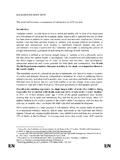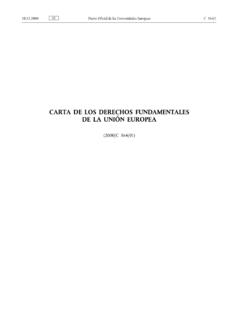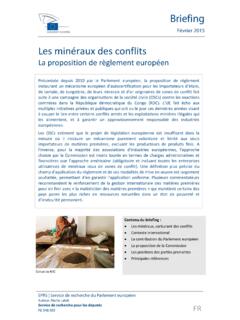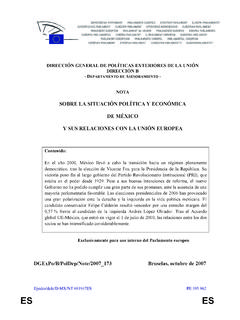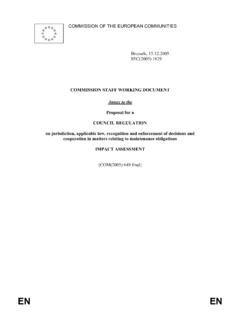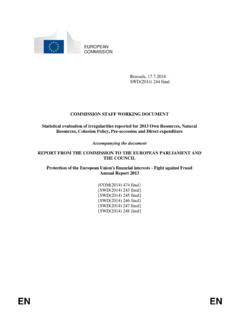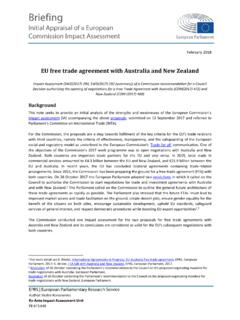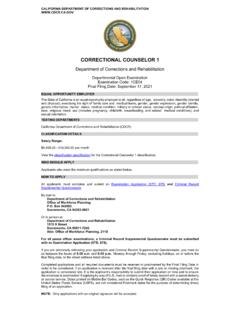Transcription of The impact of teleworking and digital work on workers and ...
1 STUDY. Disability Requested by the EMPL committee The impact of teleworking and digital work on workers and society Special focus on surveillance and monitoring, as well as on mental health of workers Policy Department for Economic, Scientific and Quality of Life Policies Directorate-General for Internal Policies Author: Manuela SAMEK LODOVICI et al. EN. PE - April 2021. The impact of teleworking and digital work on workers and society Special focus on surveillance and monitoring, as well as on mental health of workers Abstract The study analyses recent trends in teleworking , its impacts on workers , employers, and society, and the challenges for policy- making. It provides an overview of the main legislative and policy measures adopted at EU and national level, in order to identify possible policy actions at EU level.
2 The study is based on an extensive literature review; a web survey; interviews with representatives of European and national stakeholders; and five case studies of EU countries: Finland, Germany, Ireland, Italy and Romania. This document was provided by the Policy Department for Economic, Scientific and Quality of Life Policies at the request of the committee on Employment and Social Affairs (EMPL). This document was requested by the European Parliament's committee on Employment and Social Affairs. AUTHORS. Project manager and editor: Manuela SAMEK LODOVICI, IRS. Main report: Elena FERRARI, IRS. Emma PALADINO, IRS. Flavia PESCE, IRS. Pietro FRECASSETTI, IRS. Manuela SAMEK LODOVICI, IRS. Eliat ARAM, Tavistok Kari HADJIVASSILIOU, Tavistok Country case studies: Germany: Kerstin JUNGE, Tavistock Finland: Anna Sophie HAHNE, Tavistock Ireland: Dave DRABBLE, Tavistock Italy: Daniela LOI, IRS.
3 Romania: Cristina Vasilescu, IRS. Quality Assurance: Elena FRIES-TERSCH, Milieu SRL. ADMINISTRATOR RESPONSIBLE. Aoife KENNEDY. EDITORIAL ASSISTANT. Roberto BIANCHINI. LINGUISTIC VERSIONS. Original: EN. ABOUT THE EDITOR. Policy departments provide in-house and external expertise to support European Parliament committees and other parliamentary bodies in shaping legislation and exercising democratic scrutiny over EU internal policies. To contact the Policy Department or to subscribe for email alert updates, please write to: Policy Department for Economic, Scientific and Quality of Life Policies European Parliament L-2929 - Luxembourg Email: Manuscript completed: April 2021. Date of publication: April 2021. Republished with some corrections on pages 15, 95 and 121: June 2021. European Union, 2021.
4 This document is available on the internet at: DISCLAIMER AND COPYRIGHT. The opinions expressed in this document are the sole responsibility of the authors and do not necessarily represent the official position of the European Parliament. Reproduction and translation for non-commercial purposes are authorised, provided the source is acknowledged and the European Parliament is given prior notice and sent a copy. For citation purposes, the publication should be referenced as: SAMEK LODOVICI, M. et al., 2021, The impact of teleworking and digital work on workers and society, Publication for the committee on Employment and Social Affairs, Policy Department for Economic, Scientific and Quality of Life Policies, European Parliament, Luxembourg. Cover image used under licence from Adobe Stock The impact of teleworking and digital work on workers and society CONTENTS.
5 LIST OF BOXES 5. LIST OF FIGURES 5. LIST OF TABLES 7. LIST OF ABBREVIATIONS 9. EXECUTIVE SUMMARY 14. 1. AIMS, RESEARCH QUESTIONS AND METHODOLOGY 17. 2. RECENT AND EXPECTED TRENDS IN THE USE OF TICTM IN EU COUNTRIES 18. Scope of the analysis and definitions 18. TICTM diffusion before the COVID-19 pandemic 19. Evolution of telework before the COVID-19 pandemic 20. TICTM jobs and workers ' characteristics before the COVID-19 pandemic 23. The expansion in the use of TICTM during the COVID-19 pandemic 25. Expected future evolution of TICTM 35. 3. POTENTIAL EFFECTS OF TICTM ON workers , EMPLOYERS AND SOCIETY 38. Impacts and challenges of TICTM for workers 38. Impacts on TICTM workers ' flexibility, autonomy, and work -life balance 38. Impacts on TICTM workers ' mental and physical health and safety 47.
6 Impacts and challenges of TICTM for employers 53. Management culture and surveillance/monitoring systems 54. Telework effects on productivity and cost reductions 59. Impacts and challenges for society overall 67. Telework effects on labour market inclusion/exclusion patterns and the digital divide 67. Environmental and spatial implications of telework 74. 4. MAIN EU AND NATIONAL LEGISLATION, POLICIES, AND COLLECTIVE AGREEMENTS 81. Policy responses at EU level 81. EU level regulation relevant to TICTM work arrangements 81. EU level policies relevant to TICTM work arrangements 84. Stakeholders' assessment of EU legislative and policy measures 92. Policy responses at national level 96. Stakeholders' assessment of national policies 106. 3 PE IPOL | Policy Department for Economic, Scientific and Quality of Life Policies Response of social partners and collective bargaining at EU, national and company level 107.
7 5. CONCLUSIONS AND POLICY IMPLICATIONS 118. REFERENCES 124. ANNEXES 141. ANNEX I Methodology and Tools 141. Ia. EU stakeholders interviewed 141. Ib. List of national stakeholders interviewed by country 142. Ic. The web survey 142. Id. Web survey questionnaire 144. ANNEX II - Additional tables/figures 152. ANNEX III - Case study on Finland (only online). (2021)662904(AN. N01) ANNEX IV - Case study on Germany (only online). (2021)662904(AN. N02) ANNEX V - Case study on Ireland (only online). (2021)662904(AN. N03) ANNEX VI - Case study on Italy (only online). (2021)662904(AN. N04) ANNEX VII - Case study on Romania (only online). (2021)662904(AN. N05) PE 4. The impact of teleworking and digital work on workers and society LIST OF BOXES. Box 1: Use of TICTM before the pandemic in the focus countries 22.
8 Box 2: Teleworkability and job characteristics 27. Box 3: Use of TICTM during the pandemic- Country focus 32. Box 4: TICTM expected trends after the pandemic Country focus 36. Box 5: Risks of full-time teleworking on workers ' health in the context of the COVID-19. pandemic 51. Box 6: Telework and digital skills 70. Box 7: Summary of EU level regulations relating to TICTM 82. Box 8: The European Parliament Resolution on the right to disconnect 90. Box 9: Smart working (lavoro agile) - Law No. 81/2017, Law No. 27/2020, and Law Decree No. 34/2020 'Decreto Rilancio' (Italy) 100. Box 10: teleworking regulation in Spain 101. Box 11: Making Remote work : National Remote work Strategy (Ireland, 2021) 103. Box 12: Remote work agreements in the public sector in Sweden 110. Box 13: The French National Inter-professional Agreement on Telework 111.
9 Box 14: Collective Labour Agreement (CLA) No 149: COVID-19 Telework (Belgium, 2021) 113. Box 15: Examples of companies' teleworking agreements 114. Box 16: Company-level agreement on the right to disconnect at Volkswagen, Germany 116. Box 17: L'Or al and the domestic violence issue during the pandemic 116. Box 18: The Spanish protocol to prevent digital harassment of workers 117. LIST OF FIGURES. Figure 1: Shares of workers (employees and self-employed) with a TICTM arrangement (%), 2015 20. Figure 2: Share of workers aged 15-64 working from home by status and frequency (%), EU-27, 2006-2019 21. Figure 3: Share of workers aged 15-64 working from home by frequency of work from home (%) and country, 2006 and 2019 21. Figure 4: Share of employed aged 15-64 working from home by frequency and professional status (%), 2019 22.
10 Figure 5: Share of workers aged 15-64 usually working from home by sex and status (%), 2019 24. Figure 6: Share of workers working from home usually or sometimes as a % of total employment by age, 2019 25. Figure 7: Share of population (18+) working from home before the COVID-19 pandemic and share of those who started working from home as a result of COVID-19 pandemic (%), (April 2020 wave) 26. 5 PE IPOL | Policy Department for Economic, Scientific and Quality of Life Policies Figure 8: Share of population (18+) who started working from home due to the COVID-19. pandemic**, by sex (%), (April 2020 wave) 29. Figure 9: Employees' place of work during the pandemic, by country, EU27 (%). (June/July 2020 wave) 30. Figure 10: Hours worked from home as a percentage of total hours worked on average (pop.)


